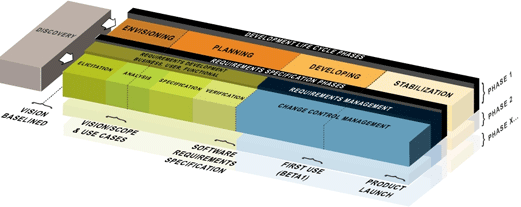Visionaire has developed a proprietary process for managing large software and hardware solutions that is based upon the Microsoft Solutions Framework. The process consists of four distinct phases: Envisioning, Analysis and Design, Construction/Development and Stabilization (Deployment/Testing).
ENVISIONING :
The envisioning phase of a project can also be considered the requirements gathering phase of the project. During this phase, the client shares its vision and all existing documentation with Visionaire to help outline the high-level requirements of the system. We will use this document as a starting point for the specific requirements of the system. The envisioning phase of the project will culminate in the creation of the Vision/Scope document.
◦ Define project parameters
◦ Identify and document project requirements and specifications
◦ Estimate the approximate size and complexity of the project
◦ Determine how the project should be implemented
◦ Estimate the precise scope and depth of the Analysis and Design phase
◦ Principal Deliverables: Scoping Document, Project Plan
ANALYSIS AND DESIGN :
The analysis and design phase is the process of determining how the solution should be built. The technical development team takes the results of the envisioning phase and plans the entire development of the solution. The planning process will end with the completion and client’s acceptance of the System Requirements Specification (SRS). The SRS describes what the solution needs to do, complete with use cases, context diagrams, a data dictionary, network topology, and detailed business requirements.
The SRS is a deliverable document that will require the client’s sign-off and approval. Any features or functions changed or added post-sign-off will go through Visionaire’s change control process, and be changed or added subject to Visionaire’s discretion. Visionaire will not continue to the development stage until the SRS is signed-off. The SRS represents the system on paper before any code is written. It is imperative that the client’s personnel review the SRS in detail.
◦ Develops detailed requirements
◦ Design prototypes
◦ Builds a logical model of solution
◦ Designs the physical system components
◦ Develops a complete architectural system model
◦ Prepares a build-and-test plan for the components
◦ Principal Deliverables: Functional Specification for the System, Overall Build-and-Test Plan
DEVELOPMENT :
The development phase is when the solution is constructed. All features and functionality outlined in the SRS will be built as specified. No new features or functions will be changed during the development stage without Visionaire’s review within the change control process.
Visionaire’s change control process includes alerting the team of the proposed or requested change, and each team lead evaluating the impact as it relates to additional work hours. Visionaire will provide Client with an estimate of the additional costs and timeline change as a result of the request.
Once all features are incorporated into the software, the development team will build an Alpha release. The Alpha release marks the beginning of the internal testing that is focused on testing the business and functional requirements.
The end of the development stage is marked by the first Beta release of the software.
◦ Builds internal releases of the system
◦ Tests each iterative release, while the next iteration is constructed
◦ Documents and defines test cases for each iteration
◦ Prepares the applications for acceptance testing
◦ Principal Deliverables: System Ready for Beta Testing and Completed Set of Test Cases
DEVELOPMENT AND STABILIZATION :
User testing begins with the first Beta release, which also marks the beginning of the stabilization stage. During stabilization, multiple Beta releases will be built and tested. Quality Assurance will identify and track bugs while development will simultaneously work to eliminate bugs and stabilize the system. Normally, there are 3 Beta releases before a release candidate version is ready. The client for user, functional, and business requirement compliance will evaluate each release candidate. The end of the stabilization phase is marked by the final client acceptance and sign-off of the software solution.
TESTING :
◦ Performs functional “Acceptance Testing”
◦ Deploys an “alpha” release
◦ Creates a simulated production environment
◦ Performs stress testing
◦ Prepares the production environment.
◦ Principal Deliverable: Deployment-Ready System
DEPLOYMENT :
◦ Use one or more beta test cycles
◦ Train users and support personnel
◦ Deploy the system
◦ Monitor system performance and make modifications as required
◦ Principal Deliverable: System in Production

